|
We continue our exploration of the Healing Yoga for Cancer Survivorship protocol this week with several breathing awareness techniques that may help to reduce stress and create a calmer state of mind. 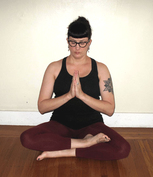 State Your Intention During the first yoga session you will create an intention for your yoga practice. Each time before you practice, sit comfortably with the eyes closed and bring to mind this resolve, state it silently three times with your full awareness. 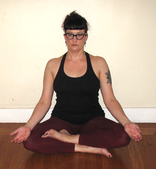 Vowel Spiral A-E-I-O-U-M Begin in a comfortable seated position (you may sit in a chair if needed).Take a few breaths into the lower belly and exhale naturally through the nose. When you are ready to begin, chant the sounds at a natural speaking pitch. You may also place your hand over the areas of the body where the vibration is strongest.
4-PART BREATH, MUDRA, MANTRA MEDITATION This 4-part breath, mudra and mantra meditation isespecially helpful for fostering emotional well-being. It highlights the four natural parts of the breath cycle with a mudra and mantra to allow the mind to be completely absorbed in the practice and can be used whenever you feel the need to reconnect with the life giving energy that each breath offers and with the trust inherent in our true nature. 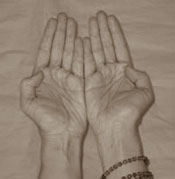 Avhana Mudra Begin in a comfortable seated position (you may also sit in a chair if needed). Turn the palms up touching the pinkie side of the hands together. Press the bent thumbs into base of index finger and keep the other fingers close together. As you inhale, say mentally "I accept" and draw the hands toward the body. Intended Benefits: Increases ability to receive help from others from others 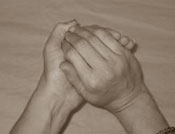 Samputa Mudra Cup hands right over left creating a hollow space between the palms. During the pause after the inhale, say mentally "I am grateful". Intended Benefits: Acknowledges the gifts you carry within 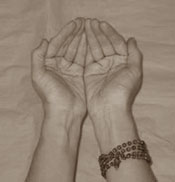 Pushpanjali Mudra Cup hands with little and ring fingertips together creating a offering bowl shape. As you exhale, say mentally "I give" and move hands away from the body. Intended Benefits: Encourages compassion, generosity, giving 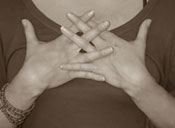 Vajrapradama Mudra Clasp fingers together and open the palms toward heart; point thumbs upwards and hold the hands a few inches away from the heart. During the pause after the exhale, say mentally "I trust" Intended Benefits: Builds confidence, security, and trust BREATHING PRACTICES Bringing conscious awareness to the natural breathing process can have a profoundly relaxing and healing effect on the mind and body. We will practice three techniques here that can be done after your yoga practice or at any time throughout the day; alternate nostril breathing which balances the work of the nervous system, belly breathing which creates a state of peace and calm, and exhale retention which further releases stress and tension. 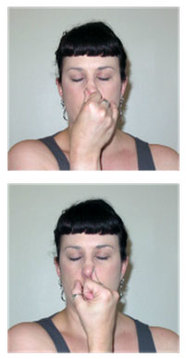 Alternate Nostril Breathing Begin in a comfortable seated position (you may also sit in a chair if needed). Use the right hand and close the right nostril with thumb. Breathe in through the left nostril, the change nostrils by closing the left nostril with the ring finger and breathe out through the right nostril. Breathe back in through the right nostril, then change the fingers again and breathe out through the left nostril. Try to hold the hand directly in front of the face so that you do not have to turn the head. Practice for up to 10 rounds, increasing the number of rounds gently as your comfort level allows. Intended Benefits: Balances the sympathetic nervous system (fight or flight) and the parasympathetic nervous system (rest and digest), increases communication between the right and left hemispheres of the brain. 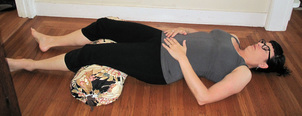 Belly Breathing Lay on the back with support under the head and knees if needed, close eyes and feel the breath moving in and out of your nostrils. Place the hands on the lower belly. Inhale and feel the fullness in the belly, exhale and feel the surrender in the belly. Practice for up to 5 minutes. Intended Benefits: Calms the nervous system, grounds the emotions, and relaxes the body. 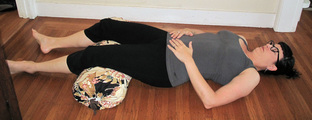 Exhale Retention Lay on the back with support under the head and knees if needed, close eyes and feel the breath moving in and out of your nostrils. Rest the hands on the floor with the palms facing upwards. Inhale into the belly and exhale slowly and completely, extending the length of the exhalation slightly. Begin to rest in the pause after the end of the exhalation for a moment before breathing in. Long slow inhale, longer slower exhale and pause. Practice for up to 5 minutes. Intended Benefits: Calms the nervous system, grounds the emotions, and relaxes the body. 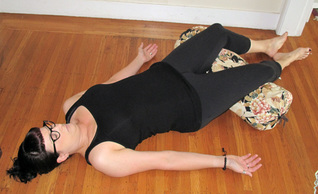 Relaxation Pose Lay on the back with legs straight and feet relaxed to sides. Move arms away from sides slightly and turn palms to face the ceiling. You may use support under the knees for low back pain; and a folded blanket under the head if needed. Rest at least 5 minutes. Intended Benefits: Allows for integration of mind and body after asana practice, promotes restful awareness
0 Comments
This week is devoted to adding some more energetic standing postures to the healing Yoga for Cancer sequence. Remember that you can do any of these short vingettes of practice depending on how you are feeling each day. 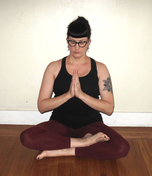 State Your Intention During the first yoga session you will create an intention for your yoga practice. Each time before you practice, sit comfortably with the eyes closed and bring to mind this resolve, state it silently three times with your full awareness. 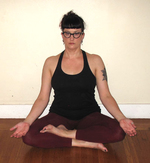 Vowel Spiral A-E-I-O-U-M Begin in a comfortable seated position (you may sit in a chair if needed).Take a few breaths into the lower belly and exhale naturally through the nose. When you are ready to begin, chant the sounds at a natural speaking pitch. You may also place your hand over the areas of the body where the vibration is strongest.
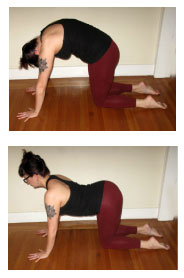 Cat/Cow Begin kneeling with the hands under the shoulders, knees under the hips with the toes pointed. As you inhale, lengthen the spine from the crown to the tailbone. Cat: As you exhale draw the belly in, round the back and drop the head and tail bone towards the floor. Cow: As you inhale arch the back lifting the sternum forward and the tailbone up towards the ceiling, pulling the shoulder blades down the back. Repeat at least 5 times with the breath. Intended Benefits: Massages the internal organs, stretches the muscles along the spine, assists with lymphatic drainage 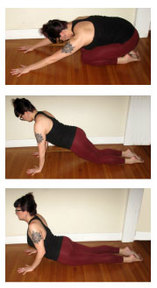 Extended Childs Pose to Cobra Extended Childs Pose: From a kneeling position, step the hands forward a few inches and then exhale into Childs pose with the arms extended overhead on the floor. Only go back as far as your knees will comfortably allow. Knee Plank: As you inhale move the torso forward bringing the shoulders over the wrists and the torso in a plank position. Then exhale back into Extended Childs Pose. Cobra: If it is available to you, you may also bring the torso all the way forward into a gentle back bend with the elbows bent, the heart lifting and the pelvis close to the floor. Then exhale back into Extended Childs Pose. Repeat at least 5 times with the breath. Intended Benefits: Stretches and strengthens the front and back of body, assists with lymphatic drainage and constipation. 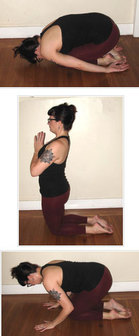 Child Pose to Extended Hero Childs Pose: From a kneeling position, exhale and sit back on the heels into Childs pose with hands beside the feet or place palms in front of the knees for more support. Alternate Childs Pose: Only go back as far as your knees will comfortably allow. You may need to place the hands in front of you and lower yourself down slowly, especially if there is knee pain or any nausea. Extended Hero: As you inhale, lift the chest, press the pelvis forward and raise hands to the heart, hands to the head or the arms straight overhead. Then exhale back into Childs pose by sitting back on the heels, folding the torso forward and bringing hands to floor beside the feet or in front of the knees. Repeat at least 5 times with the breath. Intended Benefits: Stretches and strengthens the torso, assists with lymphatic drainage and constipation. STANDING YOGA This simple standing series is perfect for days when you are feeling more energetic and will build strength in the shoulders, legs, hips and back. The focus continues to be on creating movement for lymphatic drainage, and on increasing focus and balance. 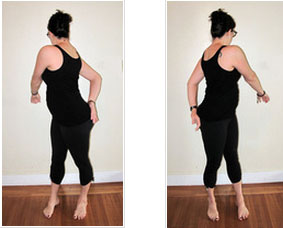 Ganeshasana Stand with the feet slightly wider than hips width apart. Begin to gently swing the arms around the body loosely as you twist the torso right and left. You may choose to bend the left knee as you are turning to the right if that is more comfortable. Close the eyes if the movement makes you dizzy. Repeat for up to 1 minute. Intended Benefits: Encourages lymph to move throughout the body 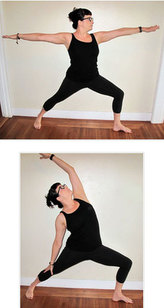 Warrior II Series Stand with feet wide apart. • Turn the right foot out 90 degrees and the left heel back about two inches so that the right knee points towards the right toes and the pelvis to the left corner of your mat. • Inhale and bring hands to hips or raise arms up to shoulder’s height • Exhale and bend the right knee over right ankle • Inhale raise right hand to the head or the right arm overhead as you reach the left hand towards back thigh. • Exhale return arms to parallel to floor • Inhale and straighten the right knee • Exhale and release arms to the sides • Repeat with the breath 3‐5 times per side. • Intended Benefits: Strengthens legs and torso, stretches belly and back, increases circulation, articulates work in feet. 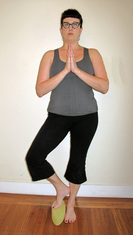 Tree Pose Stand with block between feet. Lift right foot onto block and turn leg out until heel rests on inside of left ankle. Keep hips level and bring hands to heart. Keep the entire left foot in contact with the floor, pressing especially into the ball of the big toe. Find something to focus on that is at eye level or lower to allow your eyes and mind to quiet, this will help your balance and your focus. • Hold for 5‐10 breaths per side and come down with control. • Intended Benefits: Strengthens legs and improves balance. 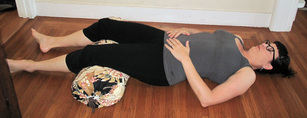 Belly Breathing • Lay on the back with support under the head and knees if needed, close eyes and feel the breath moving in and out of your nostrils. • Place the hands on the lower belly. Inhale and feel the fullness in the belly, exhale and feel the surrender in the belly. • Practice for up to 5 minutes. • Intended Benefits: Calms the nervous system, grounds the emotions, and relaxes the body. 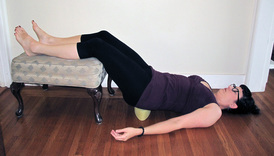 Instant Maui Lay on the back with feet on the edge of the seat. Press down in the feet and lift the pelvis off the floor and place a block or a folded blanket under the back of your pelvis. The prop should be between the waistband of your pants and the tailbone. If it is too high or too low it will not feel comfortable so find that sweet spot where your sacrum parallel to the floor. Rest the arms slightly away from sides with the palms facing up. If the hips are elevated, it is best not to use a pillow for the head. Rest for at least 10 minutes. • Intended Benefits: Induces relaxation response, reduces edema in the legs and feet, relaxes lower back • Contraindications: High blood pressure, nausea We move further into the mindful movement of this series by repeating some of the quieter practices and adding a section on kneeling yoga. 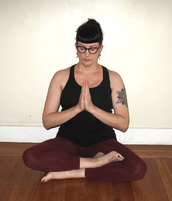 Stating Your Intention During the first yoga session you will create an intention for your yoga practice. Each time before you practice, sit comfortably with the eyes closed and bring to mind this resolve, state it silently three times with your full awareness. 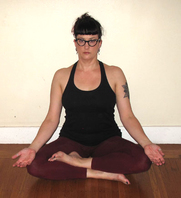 Vowel Spiral A-E-I-O-U-M Begin in a comfortable seated position (you may sit in a chair if needed).Take a few breaths into the lower belly and exhale naturally through the nose. When you are ready to begin, chant the sounds at a natural speaking pitch. You may also place your hand over the areas of the body where the vibration is strongest.
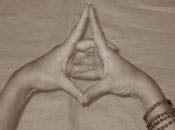 Uttarabodhi Mudra Clasp hands together and press index fingers together and thumbs together and open the center of the palms. Variation I: Hold hands in front of belly with the sides of the thumbs, heels of the hands and sides of the pinkie fingers against abdomen. Creates a sense of self-nurturance. Variation II: Hold hands in front of heart with the sides of the index fingers and sides of the thumbs against the sternum. Activates the thymus gland to increase immunity. 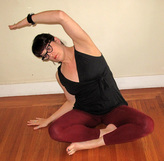 Seated Lateral Bend Begin in a comfortable seated position (you may sit in a chair if needed). Reach the crown of the head up towards the ceiling. As you inhale side bend to the right and bring the left hand to the right shoulder, or bring the left hand to the top of the head, or reach the left arm overhead with the palm facing down. The right hand is on the floor beside the hip with the elbow bent towards the body to keep the right shoulder relaxed. Keep both sit bones grounded into the floor. Exhale return to center. Repeat to both sides with the breath 5 times. Intended Benefits: Opens side ribs and facilitates breath and lymph movement throughout the torso. 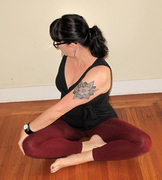 Seated Twist Begin in a comfortable seated position (you may sit in a chair if needed). Reach the crown of the head up towards the ceiling. As you inhale, draw both hands together at the heart, or to the top of the head, or raise both arms straight up overhead to create length in the sides of the torso. Exhale and twist our belly, ribs and chest to the right, bring the left hand to the right knee, the right hand on the floor behind you. Inhale and return to the center with the arms in your chosen position. Exhale and repeat to the left (shown). Repeat to both sides with the breath 5 times. Intended Benefits: Opens the ribs, massages the organs facilitates breath and lymph movement throughout the torso. 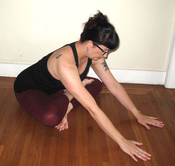 Seated Forward Bend Begin in a comfortable seated position (you may sit in a chair if needed). Reach the crown of the head up towards the ceiling. As you exhale reach the arms forward and lean the torso forward from the hips. Keep the lower back long as the navel reaches forward. Use the arms to support the body and come forward as far as feels comfortable, to the palms, or even to the forearms. Keep the pelvis grounded and breathe gently into the stretch. Hold for at least 5 breaths. Intended Benefits: Stretches the thighs, groins, hips and low back. KNEELING YOGA This gentle kneeling yoga series will deepen movement in the spine, shoulders and hips, increase breath capacity and help to move lymph through the nodes and vessels in the chest and torso. When moving the arms it is important to only stretch to a comfortable degree, especially if there are surgery sites or ports in the chest, alternate arm positions will be given so be sure to choose what is comfortable for your body today. Continue to follow the pace of your breath; it is a barometer of how you are feeling in each pose. If you find yourself holding the breath, try again a bit more gently. If you become light-headed or nauseated, stop and rest in a simple cross- legged position for a few moments before continuing. 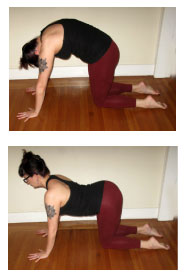 Cat/Cow Begin kneeling with the hands under the shoulders, knees under the hips with the toes pointed. As you inhale, lengthen the spine from the crown to the tailbone. Cat: As you exhale draw the belly in, round the back and drop the head and tail bone towards the floor. Cow: As you inhale arch the back lifting the sternum forward and the tailbone up towards the ceiling, pulling the shoulder blades down the back. Repeat at least 5 times with the breath. Intended Benefits: Massages the internal organs, stretches the muscles along the spine, assists with lymphatic drainage 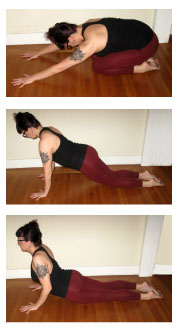 Extended Childs Pose to Cobra Extended Childs Pose: From a kneeling position, step the hands forward a few inches and then exhale into Childs pose with the arms extended overhead on the floor. Only go back as far as your knees will comfortably allow. Knee Plank: As you inhale move the torso forward bringing the shoulders over the wrists and the torso in a plank position. Then exhale back into Extended Childs Pose. Cobra: If it is available to you, you may also bring the torso all the way forward into a gentle back bend with the elbows bent, the heart lifting and the pelvis close to the floor. Then exhale back into Extended Childs Pose. Repeat at least 5 times with the breath. Intended Benefits: Stretches and strengthens the front and back of body, assists with lymphatic drainage and constipation. 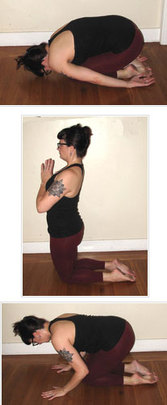 Childs Pose to Extended Hero Childs Pose: From a kneeling position, exhale and sit back on the heels into Childs pose with hands beside the feet or place palms in front of the knees for more support. Alternate Childs Pose: Only go back as far as your knees will comfortably allow. You may need to place the hands in front of you and lower yourself down slowly, especially if there is knee pain or any nausea. Extended Hero: As you inhale, lift the chest, press the pelvis forward and raise hands to the heart, hands to the head or the arms straight overhead. Then exhale back into Childs pose by sitting back on the heels, folding the torso forward and bringing hands to floor beside the feet or in front of the knees. Repeat at least 5 times with the breath. Intended Benefits: Stretches and strengthens the torso, assists with lymphatic drainage and constipation. 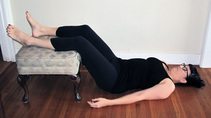 Legs in the Chair Lay on the back with the legs in the seat. If you are using a hard piece of furniture, be sure to place a folded blanket between your calves and the surface. You may also wish to use a folded blanket for a pillow. Place the arms slightly away from sides with the palms facing up Rest for at least 10 minutes. Intended Benefits: Induces relaxation response, reduces edema in the legs and feet, relaxes lower back |
Index:Archives:
September 2022
I attend Cheryl's class regularly and feel that my practice has improved immensely over the past few years due to her expert coaching. Her teaching style is clear and compassionate and her previous experience in teaching adults is evident in her organized approach and easy to understand instructions. I also appreciate that Cheryl not only teaches us about how to correctly position ourselves, but also touches on many aspects of yoga philosophy, which in turn has deepened my personal practice and heightened my awareness of the connection between mind and body, breath and relaxation. |

 RSS Feed
RSS Feed
